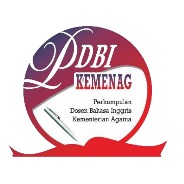A Closer Look on Student-Teachers’ Attitudes, Habits, and Their Comprehension Achievement toward Reading of Tertiary Level
Abstract
This study was aimed to find out (a) the existing phenomena of students’ reading attitudes, habit, and comprehension achievement, (b) whether or not there was significant correlation among the students’ reading attitudes, reading habits and their reading comprehension achievement, (c) whether or not there was contribution of students’ reading attitudes, reading habit and their reading comprehension achievement, (d) which variable gives the most contribution to the students’ reading comprehension achievement. The data were collected by distributing reading attitude and reading habit questionnaire and testing a reading comprehension for 313 students. The data were analyzed by Percentage analysis, Pearson Product Moment and Regression. The result showed that 1.6% students had very positive reading attitude, 95.9% students had positive reading attitude, 2.5% students had negative reading attitude. In reading habit, 23.1% students had very good reading habit, 72.3% students had good reading habit, and 4.6% students had average reading habit. There was a significant correlation between students’ reading attitude to their reading habit (.365 with sig .000). Significant correlation between either students’ reading attitude or reading habit and their reading comprehension achievement was not found. Based on their semester level, only the eighth semester students’ reading attitudes insignificantly correlate to their reading habits (.134 with sig .233). Meanwhile, only the fourth semester students’ reading attitudes correlate to their reading comprehension achievement (.290 with sig .011). In general, students’ reading attitudes contributed 13.3% to their reading habit. Finally 8.6% of the fourth semester students’ reading comprehension achievement was influenced by the combination of reading attitudes and reading habits.
Keywords
Full Text:
PDFReferences
Agustiani, I.W.D. (2012). The relationship of reading related language learning strategies and reading attitude on reading comprehension achievement of the fourth-semester students of English Education Study Program of FKIP Muhammadiyah University. [Unpublished Thesis], Palembang: Graduate Program Sriwijaya University.
Ariani, S. (2012). The relationship among attitudes toward English, language learning strategies, and reading comprehension achievement. [Unpublished Thesis], Palembang: Graduate Program Sriwijaya University
Ayhan, A. B., Simsek, S., & Bicer, A. M. (2014). An analysis of children’s attitudes towards reading habits. European Journal of Research on Education. 13-18. Beers, K. (2003). Reading strategies. Retrieved from http://www.allamericareads. org/program/strategies.htm
Best, J. W., & Kahn, J. V. (1993). Research in education. A Division of Simon & Schuster, Inc.
Butler, C. (1985). Statistics in linguistic. Basil Blackwell Ltd.
Cooper, J. D., Warncke, E. W., & Shipman, D. A., (1988). The what and how reading instructions. Merrill Publishing Company
Diem, C. D. (2011). 3-Ls: A model for teaching young learner. TEFLIN Journal, 22(2), 125-149.
Edmunds, K. M., & Bauserman, K. L. (2006). What teachers can learn about reading motivation through conversation with children. The Reading Teacher,59(5), 414-424.
Fitria, W. (2013). The correlation among reading habit, reading speed and reading comprehension achievement of the second semester students of English study program of IAIN STS Jambi. [Unpublished Thesis], Palembang: Graduate Program Sriwijaya University
Gaona, J.C.G.M., & Gonzales, E.R.V. (2010). Relationship between reading habits, University library and academic performance in a sample of psychology students. Revista De La Educacion Superior, XL(1), 55-73.
Grabe, W., & Stoller, F.L. (2001). Reading for academic purpose: Guidelines for ESL/EFL teachers. In: M. Celce-Murcia (Ed.), Teaching English as a second or foreign language (pp. 187-203). Heinle & Heinle.
Hammond, W. (2007). Peterson’s master TOEFL reading skills. Nelnet company.
Heaton, J. B. (1997). Writing English language test. Longman Inc.
Himpunan Lengkap Undang – Undang Sistem Pendidikan Nasional. (2013). Banguntapan, Yogyakarta: Saufa.
Hussain, A. (2006). Effect of Guidance Services on Study Attitudes, Study Habits and Academic Achievement of Secondary School Students. Bulletin of Education & Research, 28(1). 35-45.
Human Development Index (2013). The rise of the south: human progress in a diverse world. Retrieved from http://hdr.undp.org/sites/default /files/Country-Profiles/IDN.pdf
IEA (International Association for the Evaluation of Education Achievement). (2012). PIRLS 2011 International results in reading. Retrieved from http://timssandpirls.bc.edu/prils2011/reports/downloads/P11_IR_FullBook.pdf
Iqbal, M. (2007). The relationship among senior high school students’ reading interest, use the library and their reading comprehension. Palembang. [Unpublished thesis], Magister Program, Sriwijaya University.
Janthong, J., & Sripetpun, W. (2010). English reading comprehension and reading habit improvement: Use of questioning technique. The 2nd International Conference on Humanities and Social Sciences April 10th,2010.
Joseph, M. (2010). What is a habit?.
Karim, N.S.A., & Hasan, A. (2007). Reading habits and attitude in the digital age: Analysis of gender and academic program differences in Malaysia. The Electronic Library, 25(3), 285-298.
Kear, D.J., & Ellsworth, R.A. (1995). Children’s attitudes toward reading: A national survey. Reading Research Quarterly, 30(4), 934-956.
Kennedy, A. (2006). Examining gender and fourth graders’ reading habits and attiitudes in PIRLS 2001 and 2006.
Kubiszyn, T. & Borich, G. (1993). Educational testing and measurement: Classroom application and practice. New York, NY: Harper Collin College Publisher.
Lemmer, R.J. (2010). Do they see what we see? students’ reading habits and perceptions of extensive reading. Chugokugakuen Journal, 9(1), 1-6.
Lone, F.A. (2011). Reading habits of rural and urban college students in the 21st century. Retrieved from http://digitalcommons.unl.edu/cgi/view content.cgi?article=1617&context=libphilprac
Majid, S., & Tan, V. (2007). Understanding the reading habits of children in Singapore. Journal of Education Media & Library Sciences, 45(2), 187-198.
Mckenna, M. C., Kear, D. J., & Ellworth, R. A. (1995). Children’s attitudes toward reading: A national survey. Reading Research Quarterly, 30,934-956.
McMillan, J. H. (1992). Educational research: Fundamentals for the consumer. HarperCollins Publisher Inc.
McMillan, J.H., & Schumacher. (2010). Research in education: Evidence-based inquiry. Pearson Education, Inc.
Mikulecky, B. S., & Jeffries, L. (2007). Advance reading power. Pearson Education, Inc.
National Endowment for the Art. (2007). To read or not to read: A question of national consequence. Retrieved from http://arts.gov/sites /default/files/ToRead_ExecSum.pdf
¬OECD. (2010). PISA 2009 results: What students know and can do students performance in reading, mathematics, and science. Retrieved from http://www.oecd.org/pisa/46643496.pdf.
Owen, R. E. (2009). The process of reading. Retrieved on December 20th , 2013. Retrieved from http://www.education.com/reference/article/process-reading/
Palani, K. K. (2012). Promoting reading habits and creating literate society. International Refereed Research Journal. 2(1), 90-94.
Roe, B. D. & Ross, E. P. (1990). Developing power in reading (4th ed.). Kendal/Hunt Publishing Company.
Sadoski, M. (2004). Conceptual foundations of teaching reading. Guilford.
Sanda, S. (2011).The correlation among students’ English achievement, students’ grades, gender, parents’ profession and parents’ involvement of state senior high schools in OganKomeringUlu regency [Unpublished master’s thesis]. Sriwijaya University, Palembang.
Sani, A.M., & Zain, Z. (2011). Reading adolescents’ second language reading attitudes, self efficacy for reading, and reading ability in a non-supportive ESL setting. The Reading Matrix, 11(3), 243-254.
Schacter, D. L., Gilbert, D. T., & Wegner, D. M. (2011). Psychology (2nd ed.). Worth Publisher.
Seitz, L. (2010). Student attitudes toward reading: A case study. Journal of Inquiry & Action in Education, 3(2), 30-44.
Setyaningsih, H. (2012). The relationship among reading habit, vocabulary mastery, and reading comprehension achievement of the students of SMP N 3 Sungai Lilin. Palembang. [Unpublished thesis], Magister Program, Sriwijaya University.
Sharpe, P.J. (2004). Baron’s how to prepare for the toefl test of English as a foreign language. Barron’s Educational Series, Inc.
Smith, M.C. (1991). An Investigation of the Construct Validity of the Adult Survey of Reading Attitude. Paper presented at the annual meeting of the College Reading Association, November, 1991.
Snow, C. E. (2002). Reading for understanding: Toward and R&D program in reading comprehension. RAND.
Sugiono. (2011). Metodepenelitianpendidikan: Pendekatankuantitatif, kualitatif, dan R&D. Alfabeta
Sui-chui, H, Esther, Man-man, S., & Paul. (2003). Relationship between reading habits, reading attitude and literacy performance of 15 year old students in Hongkong and Finland. PISA International conference.
Suri, D. P. (2007). The relationship between students’ attitude toward reading and writing and their achievement in reading comprehension and writing in EFL. [unpublished thesis], Magister Program Sriwijaya University.
Strommen, L. T., & Mates, B. F. (2004). Learning to love reading: Interviews with older children and teens. Journal of adolescent & adult literacy. 48(3). 188 – 200.
Tankersley, K. (2005). Literacy strategies for grades 4-12: Reinforcing the threads of reading. Association for Supervision and Curriculum Development: Alexandria, VA.
Thanuskodi, S. (2011). Reading habits among library and information science students of Annamalai University: A survey. Kamla Raj Journal, 3(2), 79-83.
UNDP. (2013). United Nations Development Programme in Indonesia. Retrieved from http://www.id.undp.org/content/indonesia/en/home.html
Villaume, R., & Brabham, E. G. (2002). Comprehension instruction: Beyond strategies. The reading teacher. 55. 672 – 675.
Wahyudi, A. (2012). The correlation among English learning motivation, attitude and English proficiency of students of fove D3 Nursing science school in Palembang. [Unpublished Thesis], Palembang: Graduate Program Sriwijaya University.
Wallen, N. E., & Fraenkel, J. R (1990). Educational Research: A guide to the process. McGraw-Hill, Inc.
Wenden, A. (1991). Learner strategies for learner autonomy. Prentice Hall.
West, C. L. (2010). Secondary students’ reading attitudes and achievement in a scaffolded silent reading program versus traditional sustained silent reading. [Unpublished Dissertation], Auburn University.
Wood, W., & Nealthe, D. T. (2007). A New Look at Habits and the Habit–Goal Interface. The American Psychological Association. 114(4). 843 – 863.
Yamashita, J. (2007). The relationship of reading attitudes between L1 and L2: An investigation of adult EFL learners in Japan. TESOL Quarterly, 41(1), 81-105.
Zwiers, J. (2004). Building reading comprehension habits in grades 6 – 12: A toolkit of classroom activities. International reading association, Inc.
DOI: http://dx.doi.org/10.29240/ef.v7i1.7012
Refbacks
- There are currently no refbacks.
Copyright (c) 2023 Eka Sartika

This work is licensed under a Creative Commons Attribution-NonCommercial-ShareAlike 4.0 International License.
INDEXED BY:
 This work is licensed under a Creative Commons Attribution-NonCommercial-ShareAlike 4.0 International License
This work is licensed under a Creative Commons Attribution-NonCommercial-ShareAlike 4.0 International License
@ ENGLISH FRANCA : Academic Journal of English Language and Education
Jl. Dr. AK Gani No 1 Dusun Curup, Rejang Lebong Regency, Bengkulu Province, Indonesia, 39119.
Dr. Eka Apriani, M.Pd., email: efranca@iaincurup.ac.id, eka.apriani@iaincurup.ac.id.




.png)












